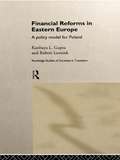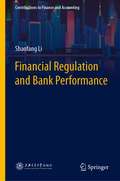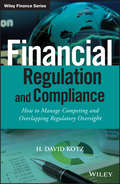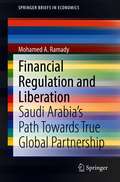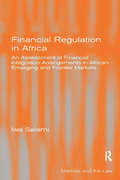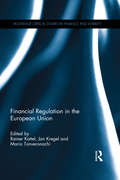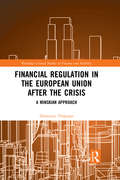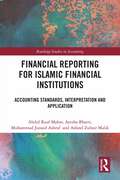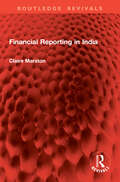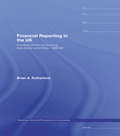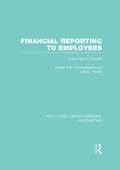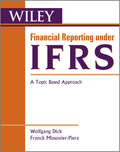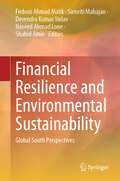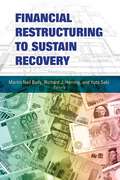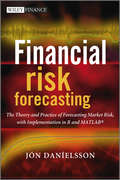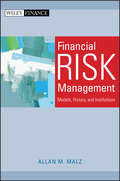- Table View
- List View
Financial Reforms in Eastern Europe: A Policy Model for Poland (Routledge Studies of Societies in Transition #Vol. 6)
by Kanhaya Gupta Robert LensinkThis book presents a model which simulates the effects of financial reforms in transitional economies, which is then applied to Poland for a variety of policy simulations. The authors develop models for households, commerical banks and firms, expanding their enquiry into the government sector, the central banking sector, the external sector and finally the supply side. These sub-sector models explicitly incorporate institutional features specific to the Polish economy. The estimated model is used to simulate the effects of a wide array of financial policies introduced in Poland, and these results are then used to assess the effectiveness of the policies analyzed. This timely and authoritative study sheds new light on how a country's overall economic system responds when it pursues a 'big-bang' approach to marketization.
Financial Regulation
by Faia, Ester and Hackethal, Andreas and Haliassos, Michael and Langenbucher, Katja Ester Faia Andreas Hackethal Michael Haliassos Katja LangenbucherThe 2007 to 2009 financial crisis resulted in the re-emergence of the debate on financial regulation and its relationships with other macroeconomic policies, particularly monetary policy. In Europe, the financial crisis was followed by the sovereign debt crisis, as the bail-out of the financial sector put strains on public finances in several countries. The sequence of events called for a strengthening of the union, ranging from a common framework for supervisory policy that could minimize the risk of unforeseen bank or country defaults to a common resolution mechanism that could set equal rules across countries and reduce ex-ante mis-incentives to risk-taking and moral hazard. This analysis of the state of and prospects for financial regulation examines the lending and saving behavior of banks and households as well as their borrowing activities in order to understand the conflicting priorities and complicated decisions involved in the development and implementation of financial legislation.
Financial Regulation and Bank Performance (Contributions to Finance and Accounting)
by Shaofang LiThis book focuses on the impact on financial regulation and examines the impact of financial regulation on bank performances from different perspectives. More specifically, this study investigates how bank sector reforms and bank regulation and supervision affect the competition, stability and risk-taking behavior in banking system.
Financial Regulation and Compliance
by H. David KotzDevise an organized, proactive approach to financial compliance Financial Regulation and Compliance provides detailed, step-by-step guidance for the compliance professional seeking to manage overlapping and new regulatory responsibilities. Written by David Kotz, former Inspector General of the SEC with additional guidance provided by leading experts, this book is a one-stop resource for navigating the numerous regulations that have been enacted in response to the financial crisis. You'll learn how best to defend your organization from SEC, CFTC, FINRA, and NFA Enforcement actions, how to prepare for SEC, FINRA, and NFA regulatory examinations, how to manage the increasing volume of whistleblower complaints, how to efficiently and effectively investigate these complaints, and more. Detailed discussion of the regulatory process explains how aggressive you should be in confronting federal agencies and self-regulatory organizations and describes how commenting on issues that affect your business area can be productive or not. The companion website includes a glossary of terms, regulations and government guidance, relevant case law, research databases, and FAQs about various topics, giving you a complete solution for keeping abreast of evolving compliance issues. These days, compliance professionals are faced with a myriad of often overlapping regulatory challenges. Increased aggressiveness on the part of regulators has led to increased demand on financial firms, but this book provides clear insight into navigating the changes and building a more robust compliance function. Strengthen internal compliance and governance programs Manage whistleblower programs and conduct effective investigations Understand how to minimize exposure and liability from Enforcement actions Learn how to prepare for the different types of regulatory examinations Minimize exposure from FCPA violations Understand the pros and cons of commenting on regulations The volume and pace of regulatory change is causing new and diverse pressures on compliance professionals. Navigate the choppy waters successfully with the insider guidance in Financial Regulation and Compliance.
Financial Regulation and Liberation: Saudi Arabia’s Path Towards True Global Partnership (SpringerBriefs in Economics)
by Mohamed A. RamadyThe book examines in depth, the centrality of the Saudi fixed currency regime to the US dollar, SAMA’s monetary tools, macro prudential policies and its supervision of the Saudi commercial banking sector and new sectors such as insurance, the emerging Fin Tech industry as well as a closer examination of SAMA’s investment policies as custodian of the local currency.Saudi Arabia has long been associated with its central role in the global energy market, with its decisions on production volumes affecting the global financial markets. However, the Kingdom has also emerged as a significant global financial player due to its large holdings of international currency, its dominance of the regional Gulf and Arab world capital markets, and the aspirations of its Sovereign Wealth Fund, the Public Investment Fund. The G20 Presidency in 2020 has also placed Saudi Arabia on the global stage for the country to showcase progress in many and opening up its financial market to foreign investors. But the path to financial regulation and liberation to unleash Saudi Arabia’s potential has not come overnight, but through incremental steps and learning by doing. The results speak for themselves as this book examines:• The Saudi Capital Market and the evolution of its main Tadawul and parallel NOMU stock markets following the inclusion of Tadawul in the FTSE Russell, MSCI and S&P EM Indexes• The centrality of the Saudi fixed peg exchange regime as well as a closer examination of SAMA’s investment policies as custodian of the local currency• SAMA’s rebranding in 2020 as a Central Bank, its monetary and macro prudential policies and the re entry of foreign banks to the Saudi market, reversing previous Saudization of foreign bank branches in Saudi Arabia. The Author offers an analysis of the key challenges facing Saudi Arabia in an age of financial globalization, FinTech and digitization. The challenges faced by the Saudi regulators in the COVID 19 era are examined, along with the country’s financial sector objectives as part of the Vision 2030 program, SME financing now a central plank in the country’s Vision 2030 program, the role of FDI in economic growth, the reasons behind Saudi Arabia languishing behind other countries in attracting FDI given the size of its economy and rising domestic and foreign debt levels. It has been an incredible journey for a young country, and by all indications, the journey for expanded global partnership continues as Saudi Arabia also puts into practice its version of the circular carbon economy, its commitment to climate change, and being at the forefront of a new global digital economy.
Financial Regulation in Africa: An Assessment of Financial Integration Arrangements in African Emerging and Frontier Markets (Markets And The Law Ser.)
by Iwa SalamiIn the wake of the global financial crisis, there has been a worldwide search for alternative investment opportunities, away from advanced markets. The African continent is now one of the fastest-growing economic regions in the world and represents a viable destination for foreign direct and portfolio investment. This book, which is the first comprehensive analysis of financial integration and regulation in Africa, fills a huge gap in the literature on financial regulation and would constitute an invaluable source of information to policy makers, investors, researchers and students of financial regulation from an emerging and frontier markets perspective. It considers how financial integration can facilitate African financial markets to achieve their full potential and provides a comparative study with the EU framework for financial integration and regulation. It assesses the implementation of effective and regional domestic infrastructures and how these can be adapted to suit the African context. The book also provides an assessment of government policies towards the integration of financial regulation in keeping with the regional agenda of the African Union (AU) and the African Economic Community (AEC).
Financial Regulation in the EU
by Raphaël Douady Clément Goulet Pierre-Charles PradierFinancial regulation has dramatically evolved and strengthened since the crisis on both sides of the Atlantic, with enhanced international coordination through the G-20 and the Financial Stability Board and, at the regional level, a definite contribution from the European Union. However the new regulatory environment has its critics, with many divergent voices arguing that over-regulation has become a root cause of our current economic stagnation. This book provides a bigger picture view of the impact and future of financial regulation in the EU, exploring the relationship between microeconomic incentives and macroeconomic growth, regulation and financial integration, and the changes required in economic policy to further European integration. Bringing together contributions from law, economics and management science, it offers readers an accessible but rigorous understanding of the current state of play of the regulatory environment, and on the future challenges. Coverage will include: * a review of the recent regulatory changes from a legal and economic perspective * analysis of how the economic model of financial institutions and entities is impacted by the new frameworks * how to improve securitization and new instruments under MIFID II * issues in the enhanced supervision under delegated acts for AIFMD, CRR-CRD IV and Solvency II * how long term funding can be supplied in lieu of the non-conventional monetary policies * a new architecture for a safer and more efficient European financial system Financial Regulation in the EU provides much needed clarity on the impact of new financial regulation and the future of the economy, and will prove a must have reference for all those working in, researching and affected by these changes.
Financial Regulation in the European Union (Routledge Critical Studies in Finance and Stability)
by Rainer Kattel Jan Kregel Mario TonveronachiThis collection offers a comparative overview of how financial regulations have evolved in various European countries since the introduction of the single European market in 1986. It includes a number of country studies which provides a narrative of the domestic financial regulatory structure at the beginning of the period, as well the means by which the EU Directives have been introduced into domestic legislation and the impact on the financial structure of the economy. In particular, studies highlight how the discretion allowed by the Directives has been used to meet the then existing domestic conditions and financial structure as well as how they have modified that structure. Countries covered are France, Germany, Italy, Spain, Estonia, Hungary and Slovenia. The book also contains an overview of regulatory changes in the UK and Nordic countries, and in post-crisis USA. This comparative approach raises questions about whether past and more recent regulatory changes have in fact contributed to increase financial stability in the EU. The comparative analysis provided in this book raises questions on whether the past and more recent changes are contributing to increase the financial stability and efficiency of individual banks and national financial systems. The crisis has demonstrated the drawbacks of formulating the regulatory framework on standards borrowed from the best industry practices from the large developed countries, originally designed exclusively for large global banks, but now applied to all financial institutions.
Financial Regulation in the European Union After the Crisis: A Minskian Approach (Routledge Critical Studies in Finance and Stability)
by Domenica TropeanoIn the wake of the financial crisis, new regulatory measures were introduced which, along with changes in monetary and macroeconomic policy, have transformed the global financial structure. However, this new financial structure displays various fragilities. A new shadow banking system has grown both inside and outside the traditional banks and the divergence between core and periphery countries’ banks has increased further due to both the new regulations and the European Central Bank’s very peculiar interventions. Following Minsky’s approach, this volume explores the interplay between monetary policy, regulation and institutions in the aftermath of the great financial crisis. Minsky’s insights are used to interpret the recent regulatory changes and consider how they have affected the evolution of banks and financial markets. The unfortunate conclusion is that the changes in financial regulation introduced in various jurisdictions and inspired by the work of the Basel Committee, have not succeeded in thwarting the instability of the economic system. Instead, the mix of policies implemented so far has brought about increased fragility in the financial system. Minksy’s work on financial stability offers alternative solutions which policy-makers need to consider to resolve these issues. Financial Regulation in the European Union After the Crisis is an important volume for those who study political economy, banking and monetary economics.
Financial Regulation: Why, How and Where Now? (CENTRAL BANK GOVERNOR'S SYMPOSIUM)
by Charles Goodhart Liliana Rojas-Suarez Philipp Hartmann David T. Llewellyn Steven WeisbrodFinancial Regulation presents an important restatement of the purposes and objectives of financial regulation. The authors provide details and data on the scale, nature and costs of regulatory problems around the world, and look at what sort of countries and sectors require special attention and policies. Key topics covered include:* the need to recast the form of regulation* incentive structures for financial regulation* proportionality* new techniques for risk management* regulation in emerging countries* crisis management* prospects for financial regulation in the future.
Financial Reporting Environment
by Paul M. Healy Robert S. Kaplan Krishna G. Palepu Amy P. HuttonProvides a framework for understanding the role of financial reporting and various intermediaries as mechanisms for reducing both adverse selection and moral hazard problems in capital markets. Financial reports reduce adverse selection by providing basic information for investors and their agents before they make initial capital resource allocation decisions. Subsequently, after capital is allocated to particular business ventures, financial reports reduce moral hazard between managers and investors by supplying information used in contracting between investors and managers to reduce conflicts of interests. Various institutional mechanisms and information intermediaries monitor and limit the manipulation of reported information by managers and constrain managers' ability to act in their own self-interest, rather than investors' interests. They also improve information production, reduce incentive conflicts, and enable capital markets to function effectively and efficiently, channeling the economy's savings to the most productive opportunities.
Financial Reporting Problems at Molex, Inc. (A)
by Paul M. HealyFollowing an accounting problem at Molex, the firm's auditors request changes in management. The board of directors has to decide whether the auditors' concerns have merit or whether, as management argues, the accounting issue is immaterial.
Financial Reporting at Mattel
by Julia Kelley Aiyesha Dey Marshal Herrmann Trung NguyenIn September 2020, Diana Ferguson, was nearing her first Audit Committee meeting as the newly appointed Audit Committee chair of Mattel, Inc. Mattel was just recovering from an accounting scandal which had revealed the company's poor internal controls and weak board oversight over financial reporting, and the committee had important decisions to make going forward. In early 2018, Mattel's Tax team had discovered a significant reporting error in its third-quarter financial results. In consultation with Mattel's independent auditor, PricewaterhouseCoopers (PwC), Mattel's finance team opted not to issue a correction and instead (effectively) concealed this mistake. This cover-up came to light in 2019, when an anonymous whistleblower reported the incident, setting off a chain of negative press coverage and senior-level resignations. Mattel responded by conducting an internal investigation, and concluded that, while their accounting processes needed to be improved, there was no evidence of fraud. Despite this, this issue had resurfaced in early 2020 when the United States Securities and Exchange Commission (SEC) launched a fresh investigation into the accounting error and subsequent cover-up. In light of these events, Ferguson and the Audit Committee faced a challenging road ahead with several important issues to consider. They needed to tackle Mattel's problematic governance and internal controls, and restore investor confidence in the company's financial disclosures. They also needed to review their earlier decision to continue to engage PwC as Mattel's auditor going forward.
Financial Reporting for Islamic Financial Institutions: Accounting and Auditing Standards, Interpretation and Application (Routledge Studies in Accounting)
by Ayesha Bhatti Abdul Rauf Mahar Muhammad Junaid Ashraf Asfand Zubair MalikMainstream accounting rules, namely International Financial Reporting Standards (IFRS), used in conventional banking, employ financial logics and principles which are at odds with Shariah and therefore unsuitable for reporting the results of Islamic banks. The book is an effort to explain the Islamic accounting principles and practices for Islamic Financial institutions and to juxtapose them to mainstream accounting principles in a simple and practical manner.The book begins with an overview of the Islamic Finance environment, the rationale for Islamic accounting and a brief introduction of AAOIFI (Accounting and Auditing Organization for Islamic Financial Institutions), the professional body responsible for the issuance of Islamic accounting standards. The main features of the AAOIFI Conceptual Framework and its comparison with IFRS framework are covered in Chapter 2. Chapters 3-9 cover the accounting treatment of the major Islamic finance products including trade-based (Murabaha, Salam and Istisna’a), rental-based (Ijarah) and risk-sharing based products (Mudarabah and Musharakah). Given the significance and complexity of Islamic bonds (Sukuk) for the Islamic finance industry, Chapter 10 discusses the basic accounting and reporting issues vis-à-vis Sukuk, leaving more complex issues for advanced texts on the topic. Zakah accounting (charity) and provisions and impairments are covered in Chapters 11 and 12.The chapters are arranged so that they start with a discussion of the product itself, followed by the AAOIFI accounting treatment and ending with the IFRS perspective. Each chapter begins with the learning objectives and a cover story and closes with a summary of the learning objectives. To facilitate the learning of readers, each chapter contains a glossary of the terms introduced as well as end of chapter multiple choice questions. In addition, each chapter includes practical insights and concept checks to enhance and test the understanding of the readers.This will be a useful guide for students, academics and practitioners concerned with the subject of financial reporting in Islamic Institutions.
Financial Reporting in India (Routledge Revivals)
by Claire MarstonFirst published in 1986, Financial Reporting in India provides a comprehensive review of Indian financial reporting and makes a comparison with the United Kingdom. The book compares and contrasts financial reporting practices in the United Kingdom and India by examining the influences on accounting practices in the two countries and by comparing the actual accounting practices and level of disclosure of information in financial reports. It concludes by providing information on the amount of influence exerted by the United Kingdom on Indian accounting practices. This book will be of interest to students and researchers of Asian studies and economics.
Financial Reporting in the UK: A History of the Accounting Standards Committee, 1969-1990 (Routledge Historical Perspectives in Accounting)
by B.A. RutherfordWritten by a well-known author, this book makes a major contribution to the history of financial reporting, exploring the current and international aspects of standard setting. Compiled through consultation of a considerable amount of relevant literature and interviews with a large number of key players of the ASC, it analyzes the big ‘set battles’ between standard setters and preparers of financial statements, over topics such as price change accounting, goodwill, and leasing and foreign currency translation, the stand-offs which delayed development in specific areas and the smaller skirmishes which impeded the work of improving financial reporting. It covers a range of topics, including: the formulation of standards on specific topics the evolution of the institutional machinery of standard-setting the politics of standard-setting the theory of accounting standardization the emergence of a conceptual framework for financial reporting. A fine account of the period following the 1960s, charting the history of the Accounting Standards Committee, this book is an essential resource for business and finance students.
Financial Reporting to Employees: From Past to Present (Routledge Library Editions: Accounting)
by Lee D. ParkerThis book introduces accountants and managers to an historical perspective of corporate financial reporting to employees. It presents a resource for research and practice based upon a literature that for its pre-1970 decades has been largely unfamiliar to contemporary educators, researchers and practitioners alike. In addition the pieces not only provide an historical view of issues and arguments, but of actual reporting practice and audience responses. For the students and researcher, these readings offer a first-hand glimpse into the intentions of employee report producers, the critiques of observers at the time, and the requirements of employees in some instances. For report producers, managers and accountants, it reveals some of the reporting traditions that we have inherited today as well as reporting practices that have already been recommended, tried and tested in the past. The readings selected cover a sixty year period from the 1920s through to the close of the 1970s, with the exception of the first contribution by Lewis, Parker and Sutcliffe (1984) that serves as the historical overview and analysis for the whole text.
Financial Reporting under IFRS
by Wolfgang Dick Franck Missonier-PieraThe International Financial Reporting Standards are quite different from other sets of accounting standards, and are fundamentally different from US-GAAP, in that they are based on principles, and not on detailed rules. Financial Reporting under IFRS:A topic-based approach offers a global perspective on IFRS by presenting the prescribed rationale and principles and illustrating them through numerous examples from large international companies. It aims to develop the fundamental skills necessary to read and use the information contained in all types of financial statements, through examples, activities, questions and answers.The book is broadly divided into three sections. Section one examines the structure of the Balance Sheet and the Income Statement, their links and the accounting mechanisms used to prepare them. Section two deals with the identification, evaluation and reporting of Balance Sheet items. Section three covers the use of financial statements to analyze a firm's performance and its risks. Throughout the book special topics are covered, including Derivatives and Hedge accounting (IAS 39), Business Combination (IFRS 3) and Operating Segments (IFRS 8).Financial Reporting under IFRS is ideally suited to the needs of students of accounting and financial reporting, but all users of financial statements, from creditors and investors to suppliers, customers, employees and governments will benefit from its concise, topic-based approach.
Financial Resilience and Environmental Sustainability: Global South Perspectives
by Shahid Amin Firdous Ahmad Malik Samriti Mahajan Devendra Kumar Yadav Naveed Ahmad LoneThis book offers a thorough examination of financial resilience and environmental sustainability, focusing on the financing of environmental sustainability, and addressing the issues, challenges, and opportunities of green financing alongside sustainable development. It presents global South perspectives on the critical issues of financing and environmental sustainability, providing policy recommendations for economies grappling with these paradoxical concerns. This book explores the challenges of financing and environmental sustainability through insights from various emerging economies. It combines theoretical, empirical, and model-based evidence to address the sustainability challenges faced by global economies, aligning with sustainable development goals. The book investigates climate change and environmental degradation challenges and examines economic strategies for a sustainable future. With over one billion people living below the poverty line, many lacking access to financial products and services, this book aims to present practical examples of financial inclusion, using the sustainable development goals as a framework. The book illustrates that comprehensive financial inclusion goes beyond credit access and bank account services, addressing the need for financially viable and accessible products and services that meet individuals' financial needs and vulnerabilities. It demonstrates how inclusive financial systems can empower those living in poverty globally, improving income levels, employment opportunities, livelihoods, and ultimately reducing poverty.
Financial Restructuring to Sustain Recovery
by Richard J. Herring Martin Neil Baily Yuta SekiHow much financial regulation will adequately reduce future systemic threats to the financial sector? To what extent can international authorities legally oversee the financial activities and outcomes of other transnational entities? Can macroprudential policy be aligned successfully with monetary policy to weather another boom-bust cycle? Editors Martin Neil Baily, Richard Herring, and Yuta Seki envision a global policy response to the financial crisis, designed to maintain sector-wide economic growth and improve profitability, rather than a response limited to secure only the strength of individual banks and nonbanks. This volume outlines how to manage factors that can endanger the financial system: how to prevent fluctuations in global capital flows; when to apply capital injection; and how to design incentives to avoid default on debt. Financial Restructuring to Sustain Recovery underscores the imperative of resolution procedures that reinforce sound financial governance, particularly in an effort to stave off future financial crises. Contributors include Kei Kodachi (Nomura Institute of Capital Markets Research), Franklin Allen (The Wharton School, University of Pennsylvania), James Barth (Auburn University College of Business; Milken Institute), Glenn Yago (Milken Institute), David Skeel (University of Pennsylvania Law School), Thomas Jackson (Simon School of Business, University of Rochester), Jay Ritter (Warrington College of Business, University of Florida).
Financial Restructuring to Sustain Recovery
by Richard J. Herring Martin Neil Baily Yuta SekiThe financial crisis of 2007-08 and the Great Recession caused more widespread economic trauma than any event since the Great Depression. With a slow and uneven recovery, encouraging stability and growth is critical. Financial Restructuring to Sustain Recovery maintains that while each part of the financial services industry can play a useful role in revving up the U.S. economic engine to full capacity, the necessary reforms are sometimes subtle and often difficult to implement. Editors Martin Neil Baily, Richard Herring, and Yuta Seki and their coauthors break recovery down by three areas:Restructuring the housing finance marketReforming the bankruptcy processReenergizing the market for initial public offeringsIncluded are lessons drawn from Japan's experience in overcoming its long-lasting financial crisis after the collapse of its real estate market in the 1990s.Contributors: Franklin Allen (Wharton School, University of Pennsylvania), James R. Barth (Auburn University College of Business; Milken Institute), Thomas Jackson (Simon School of Business, University of Rochester), Jay R. Ritter (Warrington College of Business, University of Florida), David Skeel (University of Pennsylvania Law School), and Glenn Yago (Milken Institute).
Financial Risk Forecasting: The Theory and Practice of Forecasting Market Risk with Implementation in R and Matlab
by Jon DanielssonFinancial Risk Forecasting is a complete introduction to practical quantitative risk management, with a focus on market risk. Derived from the authors teaching notes and years spent training practitioners in risk management techniques, it brings together the three key disciplines of finance, statistics and modeling (programming), to provide a thorough grounding in risk management techniques. Written by renowned risk expert Jon Danielsson, the book begins with an introduction to financial markets and market prices, volatility clusters, fat tails and nonlinear dependence. It then goes on to present volatility forecasting with both univatiate and multivatiate methods, discussing the various methods used by industry, with a special focus on the GARCH family of models. The evaluation of the quality of forecasts is discussed in detail. Next, the main concepts in risk and models to forecast risk are discussed, especially volatility, value-at-risk and expected shortfall. The focus is both on risk in basic assets such as stocks and foreign exchange, but also calculations of risk in bonds and options, with analytical methods such as delta-normal VaR and duration-normal VaR and Monte Carlo simulation. The book then moves on to the evaluation of risk models with methods like backtesting, followed by a discussion on stress testing. The book concludes by focussing on the forecasting of risk in very large and uncommon events with extreme value theory and considering the underlying assumptions behind almost every risk model in practical use - that risk is exogenous - and what happens when those assumptions are violated. Every method presented brings together theoretical discussion and derivation of key equations and a discussion of issues in practical implementation. Each method is implemented in both MATLAB and R, two of the most commonly used mathematical programming languages for risk forecasting with which the reader can implement the models illustrated in the book. The book includes four appendices. The first introduces basic concepts in statistics and financial time series referred to throughout the book. The second and third introduce R and MATLAB, providing a discussion of the basic implementation of the software packages. And the final looks at the concept of maximum likelihood, especially issues in implementation and testing. The book is accompanied by a website - www.financialriskforecasting.com - which features downloadable code as used in the book.
Financial Risk Management
by Allan M. MalzFinancial risk has become a focus of financial and nonfinancial firms, individuals, and policy makers. But the study of risk remains a relatively new discipline in finance and continues to be refined. The financial market crisis that began in 2007 has highlighted the challenges of managing financial risk. Now, in Financial Risk Management, author Allan Malz addresses the essential issues surrounding this discipline, sharing his extensive career experiences as a risk researcher, risk manager, and central banker. The book includes standard risk measurement models as well as alternative models that address options, structured credit risks, and the real-world complexities or risk modeling, and provides the institutional and historical background on financial innovation, liquidity, leverage, and financial crises that is crucial to practitioners and students of finance for understanding the world today.Financial Risk Management is equally suitable for firm risk managers, economists, and policy makers seeking grounding in the subject. This timely guide skillfully surveys the landscape of financial risk and the financial developments of recent decades that culminated in the crisis. The book provides a comprehensive overview of the different types of financial risk we face, as well as the techniques used to measure and manage them. Topics covered include:Market risk, from Value-at-Risk (VaR) to risk models for optionsCredit risk, from portfolio credit risk to structured credit productsModel risk and validationRisk capital and stress testingLiquidity risk, leverage, systemic risk, and the forms they takeFinancial crises, historical and current, their causes and characteristicsFinancial regulation and its evolution in the wake of the global crisisAnd much moreCombining the more model-oriented approach of risk management-as it has evolved over the past two decades-with an economist's approach to the same issues, Financial Risk Management is the essential guide to the subject for today's complex world.
